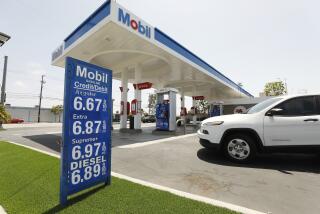As gas prices surge, White House hints it may tap oil reserve
- Share via
Reporting from Washington — As rising gasoline prices threaten to put a drag on the already sluggish economic recovery, the Obama administration is leaving open the possibility that it could draw from the nation’s emergency reserve in an attempt to reverse the trajectory.
“There’s a case for the use of the reserve in some circumstances, and we’ll continue to look at those and evaluate that carefully,” Treasury Secretary Timothy F. Geithner told CNBC on Friday.
The secretary’s hedged remarks echoed those coming from the White House all week, as gas prices surged amid market jitters over Iran’s nuclear program.
Administration officials have left on the table the option of releasing Strategic Petroleum Reserve oil but have declined to give details about what circumstances would prompt such a move.
The administration has good reason to be secretive. Even hinting at the possible use of the reserve could affect the market now, thereby reducing the impact when an official announcement is made.
Gas prices rose 12 cents over the last week to hit a national average Friday of $3.65 a gallon. Gas in California, Hawaii and Alaska averaged more than $4 a gallon.
The possibility of tapping the Strategic Petroleum Reserve often comes up when gas prices soar and politicians feel pressure to act. Releasing oil is the only tool the government has in any effort to lower prices in a hurry, though experts dispute how effective it is.
Democrats and liberal groups were the first to call on Obama to open the reserve. In a letter to the president this week, three House Democrats asked Obama to take an “aggressive” approach.
“We must carefully consider all immediate options in order to prevent a runaway increase in prices,” wrote Reps. Edward J. Markey of Massachusetts, Peter Welch of Vermont and Rosa DeLauro of Connecticut.
But analysts and Republicans are skeptical. The reserve was intended primarily as an emergency option to blunt the impact of a supply disruption. Today’s high prices for crude oil are caused partly by concerns over the potential for disruptions and the looming sanctions on Iran.
If the U.S. acts preemptively, experts said, it could squander its reserve oil and end up with fewer options in the case of an actual supply interruption. Such a disruption would occur if Iran, for example, followed through on threats to close the Strait of Hormuz.
Obama last ordered oil released from the reserve in June when unrest in Libya reduced the supply of oil by more than a million barrels a day at the beginning of the summer driving season. The U.S. and other Western countries released a total of 60 million barrels over 30 days; the U.S. share was about half.
Some experts argued that the move then was not responsible for an eventual drop in gas prices and predicted that unilateral action now, which would be limited to 30 million barrels, could have a similarly minimal effect.
“SPR is not designed to manage prices but really to support markets when there is an interruption of supply,” said J. Robinson West, chief executive of PFC Energy, an oil and gas consulting firm. “An uncoordinated U.S. release will do very little to dispel high prices.”
On Friday, the benchmark West Texas Intermediate crude rose $1.94 to $109.77 a barrel on the New York Mercantile Exchange. It peaked at $114 a barrel last May. In London, Brent crude increased $1.85 to $125.47 a barrel.
kathleen.hennessey@latimes.com
Times staff writer Christi Parsons contributed to this report.
More to Read
Inside the business of entertainment
The Wide Shot brings you news, analysis and insights on everything from streaming wars to production — and what it all means for the future.
You may occasionally receive promotional content from the Los Angeles Times.











